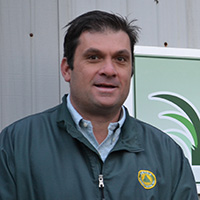Which titles have had the greatest impact on Green Industry companies? Four business owners share their must-reads.

By Bill Bemus, President
Bemus Landscape, a $21 million, full-service landscape company
San Clemente, Calif.
Man’s Search for Meaning by Viktor Frankl is one of the most challenging books I’ve ever read. I first became aware of Frankl about 20 years ago when as a company we studied another excellent book for business, Stephen Covey’s The Seven Habits of Highly Effective People.
Frankl was an Austrian psychiatrist who, along with his parents, brother and wife, was imprisoned by the Nazis in September 1942. He suffered unspeakable deprivation and degradation until being liberated by American forces in April 1945. Of those imprisoned, he was the only member of his family to survive.
Frankl wrote Man’s Search for Meaning in 1945 and meant to publish it anonymously, not wanting to earn literary fame or profit from his experiences (he was persuaded otherwise by friends). The main part of the book, “Experiences in a Concentration Camp,” describes (with a kind of eerie, clinical detachment) day-to-day life in the camp: the train ride to Auschwitz, being stripped of all clothes and valuables, the smoke from the crematorium chimneys, the cold and hunger, the guards and the deaths and suicides—the utter despair.
And yet, interspersed throughout this section are bolts of light: the ultimate freedom, no matter what the guards did, to choose his response (referenced by Covey extensively); the power of love; the necessity of having faith in the future; the power of hope; and, most importantly, the necessity of finding the why of existence.
Frankl says: “Woe to him who saw no more sense in his life, no aim, no purpose and therefore no point in carrying on. He was soon lost. The typical reply with which such a man rejected all encouraging arguments was, ‘I have nothing to expect from life any more.’ What sort of answer can one give to that? What was really needed was a fundamental change in our attitude toward life. We had to learn ourselves and, furthermore, we had to teach the despairing men that it did not really matter what we expected from life, but rather what life expected from us.”
A second section to the book, “Logotherapy in a Nutshell,” was added in 1962 in response to people wanting to understand more of his therapeutic doctrine. A third section, “The Case for a Tragic Optimism,” was added as a postscript in 1984.
In this little book, the lessons and applications for any business or endeavor are myriad, but three in particular have been helpful to me as of late.
The first is to never give up or become hopeless in the face of adversity. Sometimes it feels like running a business—especially in California—is like playing solitaire. You start with a deck of 52 cards but the government removes a card from the deck every six months or so and expects you to keep playing. That feeling of being victimized is unhealthy and needs to be resisted.
The second is to find or create meaning out of what seems to be mundane, day-to-day, trivial existence. In our industry we create and maintain beauty, we provide valuable service to our clients, we provide jobs and opportunities; these are not insignificant things.
Finally (and I will just quote Frankl here), “Don’t aim at success—the more you aim at it and make it a target, the more you are going to miss it. For success, like happiness, cannot be pursued; it must ensue, and it only does so as the unintended side effect of one’s personal dedication to a cause greater than oneself or as the byproduct of one’s surrender to a person other than oneself. Happiness must happen, and the same holds for success: You have to let it happen by not caring about it.”
When you reach a certain age (I’m 60) you begin to question what you’ve accomplished in life. Has it mattered that I’ve been here? Reading Frankl helped me understand that meaning and fulfillment are attainable without having to go far afield. Maybe it’s moving past enlightened self-interest and into wholeheartedly trying to make a difference in people’s lives; every businessman is connected to a lot of them.

By Chris Joyce, President
Joyce Landscaping, a $9 million, full-service company
Cape Cod, Mass.
I tell anyone I know in business or any management structure, whenever we’re talking about the frustrations of business, “You’ve got to read Winning by Jack Welch.”
Welch is the former CEO of General Electric. He retired in 2001 and wrote a couple books. I think someone might have said to me, “You’ve got to read this book” or maybe I heard it on a news channel, but somehow I ended up with the book in 2007. That’s when I read it for the first time. For me, who’s not big into reading, it was riveting. I kept wanting more and more information he was discussing. I couldn’t put it down. It doesn’t get much activity anymore, though. I got lazy and bought it on CD. When I find myself in a rut I will throw it in my car and go through the discs. It energizes me.
I just love his approach and his stories. A lot of the stuff is human nature. It just represents itself differently. Basically, the title says it all. It’s all about winning with people. In business you want to win and you win with people. It’s simple.
The discussion on candor, which is in chapter 2, is probably the best chapter in the book. You have to have candid conversations with people. And that’s probably our biggest challenge. Motivating people and understanding people is challenging. It gets frustrating at times.
He also talks about getting the right people on your team and how first you’re the manager and then you have to be a leader yourself. You have to be a success individually before you can lead others. He breaks it up into your top 20, which is your top-end managers or your high performers. He delineates to your bottom 10, which you’re going to push out of your organization, and then he says, “Your middle 70 is what you need to cultivate.” Your middle 70 needs to be heard to be a part of the team. Instead of all decisions, policies and procedures being made from the top, he says to implement and develop a communication with the middle 70 so they have a word and they have buy-in within the development of the business.
It made me realize I would constantly get frustrated with my middle group. After reading this book, it really made me open up my eyes and say: “That’s human nature. That’s what people are. Those people actually have a lot to offer.” You have to cultivate those people through communication through your culture within your organization. The middle 70 is really what makes up your business. Successful, winning teams get the most out of their middle 70.
I find myself sometimes getting away from that (mentality) and that’s when I have to revisit the book. I listen to it probably once a year when I find I have to kick myself in the ass a little bit. It actually is in my car right now. —As told to Sarah Pfledderer

By Chris Clifton, Owner & President
Southview Design, an $11 million, primarily design/build firm
Minneapolis
About three years ago I read Gino Wickman’s book Traction. Wickman is the founder of an organization called EOS Worldwide, a consulting and coaching group focused on helping companies in the $2 million to $50 million revenue range achieve and manage growth. Traction is the handbook that summarizes EOS’s core teachings.
I bought Southview Design in 2009 when it was doing about $5 million in sales. In spite of the recession, I felt the company had a solid foundation and the potential to grow. Though I’ve been involved with various businesses over the years, I was looking for tools to help me with this one. A friend gave me a copy of Traction, thinking it might provide some insight.
Traction builds on the idea that most businesses get to a point where management becomes frustrated because progress has slowed or stopped altogether. The book identifies six components essential for sustainable growth and profitability:
- Vision. Leaders in successful companies not only have compelling visions, they know how to communicate them.
- People. It’s impossible to build a great company without help. Successful companies get the right people into the right seats.
- Data. Wickman advocates use of a “scorecard,” a weekly report containing five to 15 high-level, performance-indicating numbers or measurables.
- Issues. Issues are the obstacles that must be faced to execute the vision. The good news is that in the history of business, there have only been a handful of different kinds of issues. The same ones come up over and over again. Companies that deal effectively with their issues achieve their visions.
- Process. Successful organizations see their way of doing business clearly and work to constantly refine it. Key processes are well documented and followed by all. This is the most neglected of the six key components.
- Traction. “Vision without traction is merely hallucination,” Wickman says. The “traction” component deals with action and accountability. The book says organizations should establish three to seven priorities, referred to as “rocks.” These are the organization’s most important priorities that must be accomplished in the next 90 days. This component also deals with “meeting pulse,” a series of meetings at different levels of the organization, ultimately designed to ensure the company’s vision is achieved.
I found the advice in Traction to be simple and practical, based on the real world and not theoretical or faddish. Much of how I run Southview Design is based on Traction ideas and I refer back to it on a regular basis.
Recently, we’ve refocused on the process component. Growth has stirred excitement in the organization, but it’s also added complexity and the need to hire more people. We need to make it easier for everyone to understand how we want them to do business. Right now we are in the midst of redefining and documenting any and every process we can think of.
Between the ideas gained from Traction and other improvements we’ve made to the business, our results have been good. We reached $11.2 million in revenue in 2013 and I expect we’ll continue to grow.
I recently read Wickman’s follow up book Get A Grip, written in conjunction with his colleague Mike Paton. It’s written in fable format and tells the story of an individual company working its way through the Traction process. I thoroughly enjoyed it as well and would recommend either book to anyone looking to grow a small business into a mid-sized one.

By Richard Bare, CEO
Arbor-Nomics Turf, a $7 million, primarily lawn care company
Norcross, Ga.
The premise of the book is that we all operate based on long-term assumptions that may not be true, even though they’re logical. For instance, one would assume logically that if an employee wrecks a truck a few times, he or she would become a better driver. However, in real life, poor drivers have been proven to be just that, poor drivers. No matter how many times they wreck, they continue to do it, because they drive differently. They’re distracted, careless, unfocused and cavalier.
I read the book about five years ago when our company was 30 years old. I was 60. I knew from experience the basic tenets of the book were completely correct. I’ve only read it straight through once, but I refer back to it many times.
After reading the book, I tried to apply its main message to my business: “People don’t change that much.” Rather than trying to change people, you’re better off trying to draw out what’s there and what works. I’ve had many customer service reps who are great at answering the phones, taking notes for call backs and charming customers. But give them accounting/bookkeeping responsibilities and they’re terrible. They cannot be trusted with a checkbook. Awhile back a customer service representative asked me, “How can I be overdrawn if I still have checks left?”
We’ve greatly improved our hiring processes since reading the book. We look for clues as to what makes up a person but also for problems that will surface. For instance, if we’re hiring for a spray tech position, we look for excessive tattoos, body piercing, cigarette smoking, souped up personal car, off-beat dress, slouching body language and messy family life, which all are red flags that this person is not a team player and probably won’t fit in.
This book is full of leadership ideas for the entrepreneur. I frequently recommend it to others.

